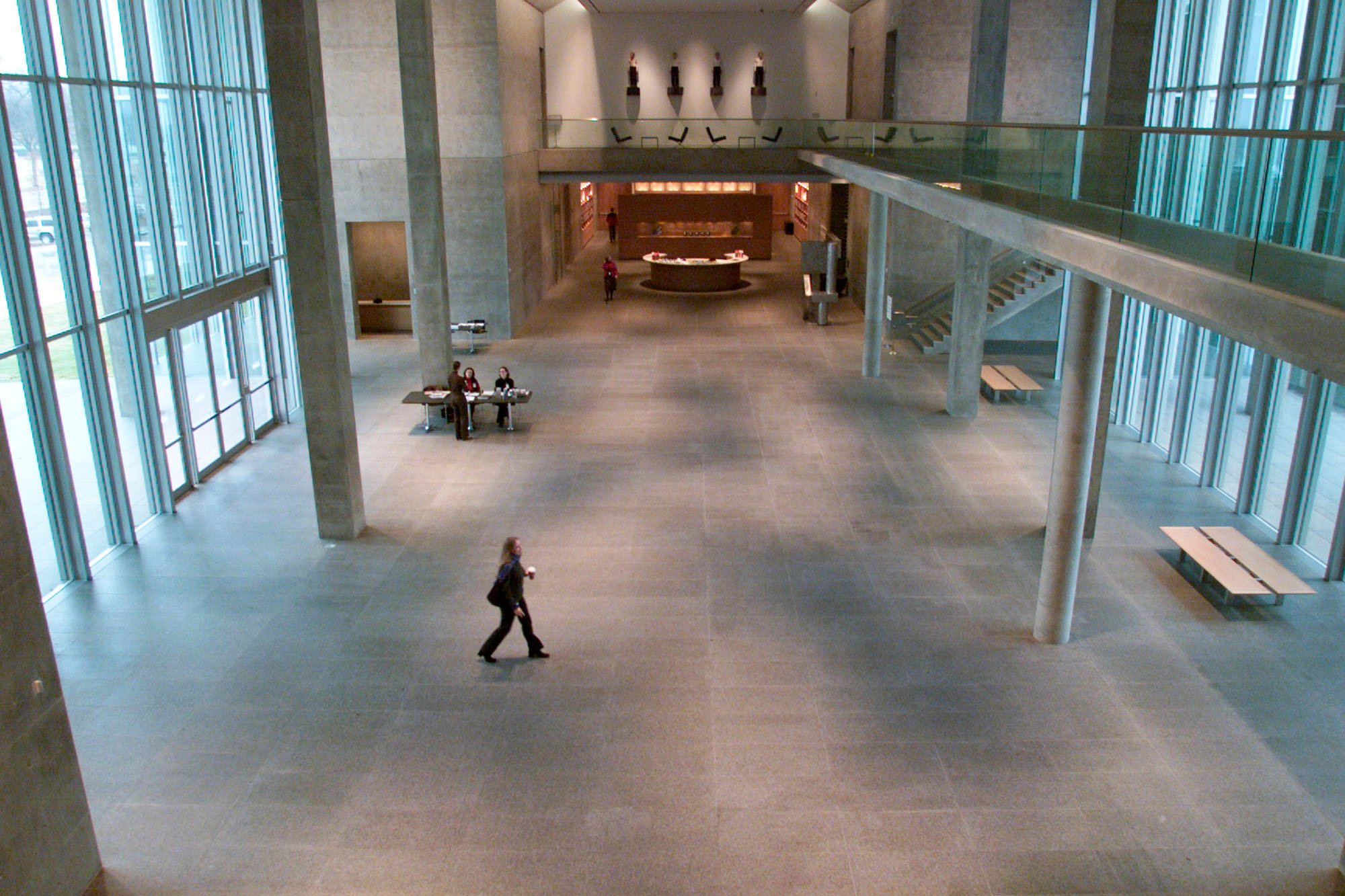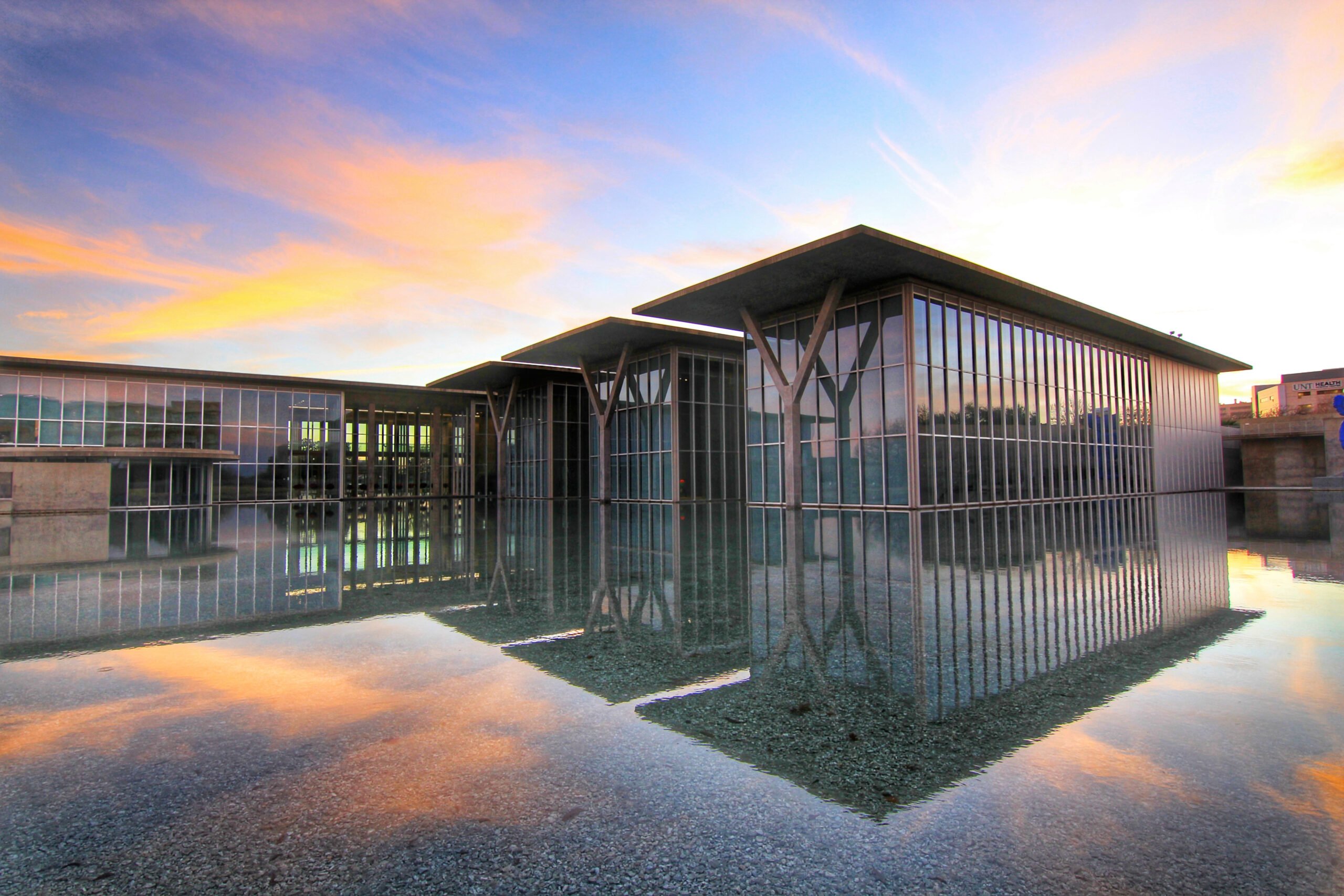When police removed four photographs by Sally Mann from the Modern Art Museum of Fort Worth in early January, Marshall K. Harris, a former NFL player-turned-local artist, wasn’t surprised. Local politics had been shifting to the right recently, especially since the election of conservative firebrand Tim O’Hare as Tarrant County judge in 2022. Furthermore, a nationwide cultural shift toward right-wing censorship, evident in activist book-banning efforts across Texas in the past few years, had been further invigorated since the reelection of President Donald Trump in November.
Harris wasn’t shocked either, when the photos—much-lauded and long-controversial 1980s pictures of Mann’s young children nude—were held as evidence for more than three months in what may be the most significant police investigation of a museum art show in the United States since 1990.
Instead, what amazed Harris was the silence that predominated across the Fort Worth art scene surrounding the matter.
Harris, who was a standout defensive end at Fort Worth’s Texas Christian University before his four-year NFL career, is one of few outspoken voices in an art community on edge in the face of an ascendant right-wing political force. “For an institution like the Modern to be caught in this situation, and then everybody goes silent?” he told me in February. “Everybody. You can’t talk to anyone. And I sort of wonder if me opening my big mouth puts me at risk of reaction. Nobody wants to say anything to possibly get themselves in any trouble.”
The photographs, seized by police in early January and finally returned to the museum in April after a grand jury declined to issue indictments in the case, are from Mann’s Immediate Family series, which includes both nude and clothed images of her children growing up on a remote Virginia farm. The photos removed from the Modern include a shot of the torso and genital region of Mann’s approximately 6-year-old son after eating a Popsicle that dripped down his naked body, and another wider shot of Mann’s approximately 8-year-old daughter jumping naked onto a picnic table. Mann’s three children are all now in their 40s or deceased; they were involved as adults in selecting Immediate Family nudes for inclusion in Mann’s memoir, published in 2015.
THE PHOTOS IN IMMEDIATE FAMILY HAVE DRAWN CONTROVERSY SINCE MANN FIRST SHARED THEM WITH THE PUBLIC IN 1992.
The photos were dogged by controversy in the ’90s, and they still make some viewers uncomfortable today. But they have also become part of the mainstream canon of American photography, admired by many as beacons of autobiographical art.
Mann did not respond to requests for an interview for this story. Nor did the Gagosian Gallery, which loaned the photos to the Modern. The Modern has said very little beyond noting that the works in question “have been widely published and exhibited for more than 30 years in leading cultural institutions across the country and around the world.” Other Fort Worth museums, city council members, and several artists with work in the same exhibition as Mann’s photos all ignored or declined requests for interviews. Most remarkably, city police refused to release any information pertaining to the investigation, arguing, among other reasons, that “records of alleged or suspected abuse or neglect of a child are confidential.”
As details failed to trickle out, members of the Fort Worth arts community shared gossip, looking for answers, and mostly came up empty. “I’m trying to get a better handle on it, but every single employee at the Modern has been told not to talk about this at all,” said Wesley Kirk of the nonprofit Support Fort Worth Art. “I’ve been surprised that Kimbell and Amon Carter haven’t been speaking up, because this sets a bad precedent.”
Kimbell Art Museum, Amon Carter Museum of American Art, and the Modern Art Museum of Fort Worth form a trinity of world-class, well-endowed art museums in the heart of one of the most conservative big cities in the United States. Until recently, this had not led to public confrontations.
“I’ve lived here for 40-something years, and I’ve seen all sorts of things at those museums that some people would consider inappropriate and others would not,” said Lauren Saba, proprietor of the Fort Works Art gallery. “I hope this is an isolated incident.” Saba noted that, in November 2024, her gallery ran an exhibition of provocative art called “Ban This Show”—including a video titled “God Save Abortion” by Nadya Tolokonnikova of Pussy Riot—and received no pushback.
Yet it’s difficult to consider the events at the Modern as entirely isolated. In October, Amon Carter’s exhibit “Cowboy,” which promised to “disrupt the homogenous ideal of the cowboy as a White, cisgender American male and showcase the diverse manifestations of this figure across communities,” shut down without explanation and reopened a week later with a trigger warning. The show featured images of naked men swimming together and men in cowboy getups partner-dancing and kissing.
The origin of the police-led art heist lay in a public backlash stoked by local conservative media, institutions, and politicians. Sharayah and Scott Colter, respectively the communications director and CEO for the Danbury Institute, a religious-rights group with Baptist roots, went to see the Mann photos in December at the Modern after an article in a right-wing news outlet, the Dallas Express, called the works pornographic. The Colters, upon seeing the photos for themselves, were horrified.
“It was even worse than we imagined,” said Sharayah, who splits time between Dallas and Washington, D.C. “We did not even take pictures of it, because we don’t want that kind of content on any of our devices. It’s really obscene material. It definitely does not belong in a museum. It should never have been taken in the first place. And yes, I do believe it belongs with the police.” The Danbury Institute then gathered around 20,000 signatures for an open letter invoking Biblical principles to call for the Modern to remove the Mann nudes.
Colter said she didn’t know how the Fort Worth police investigation came to be. She credited the Dallas Express—a nonprofit outlet that repurposed the name of a defunct Black-owned paper and routinely promotes the causes of its publisher, GOP megador and hotelier Monty Bennett—which published a series of alarmist articles by Carlos Turcios preceding the police investigation.
Colter also praised Bo French, leader of the Tarrant County Republican Party, and Tarrant County Judge Tim O’Hare for being early to comment on the issue. Before the police action, O’Hare told the Dallas Express that the photos “should be taken down immediately and investigated by law enforcement for any and all potential criminal violations.” In an email, French told me that Mann’s photos “could even be construed as child pornography.” He was particularly critical of text describing Mann posing her children “naked, moody, and in suggestive situations” to “evoke an edgy, dark side of childhood” that appeared on the wall at the Modern.
“That should repulse everyone except perhaps the most vile degenerates,” French said.

Some in Fort Worth see O’Hare’s hand in the investigation. Kirk said an incident like this would not have happened before O’Hare won office as county judge two years ago. Indeed, O’Hare has taken a hardline approach on far-right pet issues. During his tenure, he’s pushed to withhold funding from groups helping at-risk children over their views on LGBTQ+ issues, agitated for restrictive voting laws to benefit Republicans, and shown a draconian streak by ordering the removal of a pastor from a public meeting for speaking over his allotted time. Since his days as the young mayor of suburban Farmers Branch, complaining about undocumented immigrants to national media like CNN and pressing for “Chili’s-type restaurants” rather than more authentically Mexican establishments in town, he’s displayed a gift for knowing which issues will rally conservative support.
But a county judge is an executive position in the county government, analogous to the mayor of a city. O’Hare has no formal role in law enforcement.
It remains unclear who or what pushed the Fort Worth Police Department (FWPD) to pursue an investigation with no clear precedent among successful criminal prosecutions. Since the photos were returned, an additional baffling detail has emerged: FWPD spent $7,000 on travel to New York City to investigate “critical leads” pertaining to Mann’s photos, which are already among the best-studied and most-discussed works in U.S. contemporary art.
The photos in Immediate Family have drawn controversy since Mann first shared them with the public in 1992. A New York Times Magazine article that year questioned Mann’s fitness as a mother. A Wall Street Journal editorial went further, calling for the photos to be censored. The uproar played an important role in bringing the work to a wider audience. That exposure, in turn, attracted a stalker to Mann’s youngest daughter, causing difficulties for Mann’s family for years.
The frightening trade-offs of this sort of expression—now the sort of thing that all parents must consider in the era of social media—are enough to make many viewers queasy. “Mann’s a very controversial figure,” Saba said. “I think if you poll 10 moms, you get a half-and-half reaction.”
Mann has often been in the position of having to defend her art. Her stated impetus to make what she calls her “family pictures” was a mix of motherly adoration and deep fascination with her children’s private world, growing up on the same family farm where Mann herself had spent her childhood. “In the pictures of my children I celebrated the maternal passion their bodies inspired in me—how could I not?—and never thought of them sexually or in a sexual context,” she wrote in her 2015 memoir, a portion of which was excerpted in the New York Times Magazine.
In the memoir excerpt, Mann recounted being shocked and disoriented by the ’90s-era backlash. She was distressed when the Wall Street Journal published a portrait of her unclothed daughter with black bars censoring her nakedness—additions that Mann said “mutilated her innocence” and made the work appear scandalous. (The Dallas Express, in December, replicated the Journal’s approach when publishing Mann’s photos.)
It’s unclear how FWPD could have expected that this criminal investigation would result in conviction. The First Amendment’s protection of free expression is very broad, explained Lee Rowland, executive director of the National Coalition Against Censorship (NCAC). Two narrow exceptions are carved out for obscenity and child pornography. But Mann’s work does not qualify as either.
Under a 50-year-old ruling in Miller v. California, an expression must lack any serious artistic, literary, or scientific value to qualify as obscenity. It’s basically impossible for a work of art hung in a museum, selected by trained curators, to be seen to lack such value. “For someone of Sally Mann’s stature and longevity, the idea that her work and photography has no value does not even meet the laugh test, and it certainly doesn’t meet the test for obscenity,” Rowland said.
A separate legal test for child pornography depends on showing a child in a sexual activity or in a way intended to arouse the viewer, Rowland added. Just depicting nudity is not enough to fail this test, under U.S. code and 40-year-old precedent in New York v. Ferber.
“It’s very important that the definition of child pornography remain narrow and tethered to those realities, for the simple reason that child nudity is a completely natural and rather massive part of childhood existence, and it is widely celebrated as a cultural matter,” Rowland said, pointing to the many depictions of nude baby Jesus over the centuries. “Child nudity itself may be challenging for some people, but [it] is widely culturally accepted as a natural and non-sexual part of growing up.”
Throughout American history, police have steered clear of dictating what should and shouldn’t be allowed in museums—apart from a single incident in 1990 when employees of Cincinnati’s Contemporary Arts Center were prosecuted (and eventually acquitted) for displaying photographs by Robert Mapplethorpe, including nude adults in BDSM poses and two nude images of children.
That episode came at the peak of a previous era of culture war, which may now be on the point of breaking out anew. Then, as now, sexual identity played a shadowy role in the right’s censorious fervor: Mapplethorpe was gay, having died of AIDS a year before the exhibition. The original Dallas Express article decrying Mann’s photographs also alerted readers to photos in the Modern show depicting LGBTQ+ content, including an autobiographical video about parenthood by queer and nonbinary artist Jess Dugan.
“It’s almost like Tim O’Hare is reading a script written by Jesse Helms 30 years ago,” observed Natalie Zelt, a postdoc at the University of Texas at Austin who leads a collaborative scholarly project on the history of photography curation called “Framing the Field.” Helms was a Republican U.S. senator who used Mapplethorpe, among other controversial artists, as a wedge to change the way the National Endowment for the Arts funded artists. This summer, the Trump administration has made major cuts to the endowment’s programs, an assault on the institution not seen since Helms’ era.
The police investigation in Fort Worth may be over, but its effects could be long-lasting in the local museum and art scene. Multiple locals and experts expressed concern that the city’s museums would be more hesitant to show any work that might offend political officeholders or activists—or put board members and donors in jeopardy. Elizabeth Larison, director of the Arts & Culture Advocacy Program at NCAC, worried that such an outcome “reduces the display of art to the lowest common denominator.”
Regardless of the courage of museum officials, big-name artists may not want to or even be allowed by insurance companies to bring their expensive works to a town where an overzealous police department could seize them for extended periods on thin legal pretense. “Artists of that caliber, they’re going to look at the Fort Worth area with some skepticism,” warned Harris, the ex-NFL player. “Like, ‘Do I even want to enter into that fray?’”
On the other side of the equation, right-wing censors are emboldened and looking beyond the city limits. Rowland described a push across several GOP-controlled states, including Texas, Florida, and Oklahoma, to beef up obscenity laws. “There is a real concerted effort to change the definition to apply effectively to all images of nudity—not just children,” she said. In the Texas GOP platform for 2024, the first item on the “criminal and civil justice” agenda calls for changes to the penal code to broaden obscenity enforcement.
In the December 26 article on Mann’s photos in the Dallas Express, GOP state Representative David Lowe, who represents part of the Fort Worth area, was quoted promising legislative action this year. “It is crucial that our legal framework leaves no room for predators to misuse the realm of art to display child nudity,” he told Turcios. “Should any loopholes exist, we are prepared to address and eliminate them in the upcoming legislative session in Texas.”
In March, Lowe introduced a bill in the Texas House of Representatives which would have created a mechanism for civil penalties against museums that display “certain obscene or harmful material.” The measure never got a hearing, but, as Texas Republicans continue to push the envelope on culture-war issues, it’s easy to imagine it returning soon in some form.
In other words, what started in Fort Worth this January could soon affect museums across Texas, and perhaps eventually elsewhere in the country. Silence may not be enough to forestall it.
(Except for the headline, this story has not been edited by PostX News and is published from a syndicated feed.)


